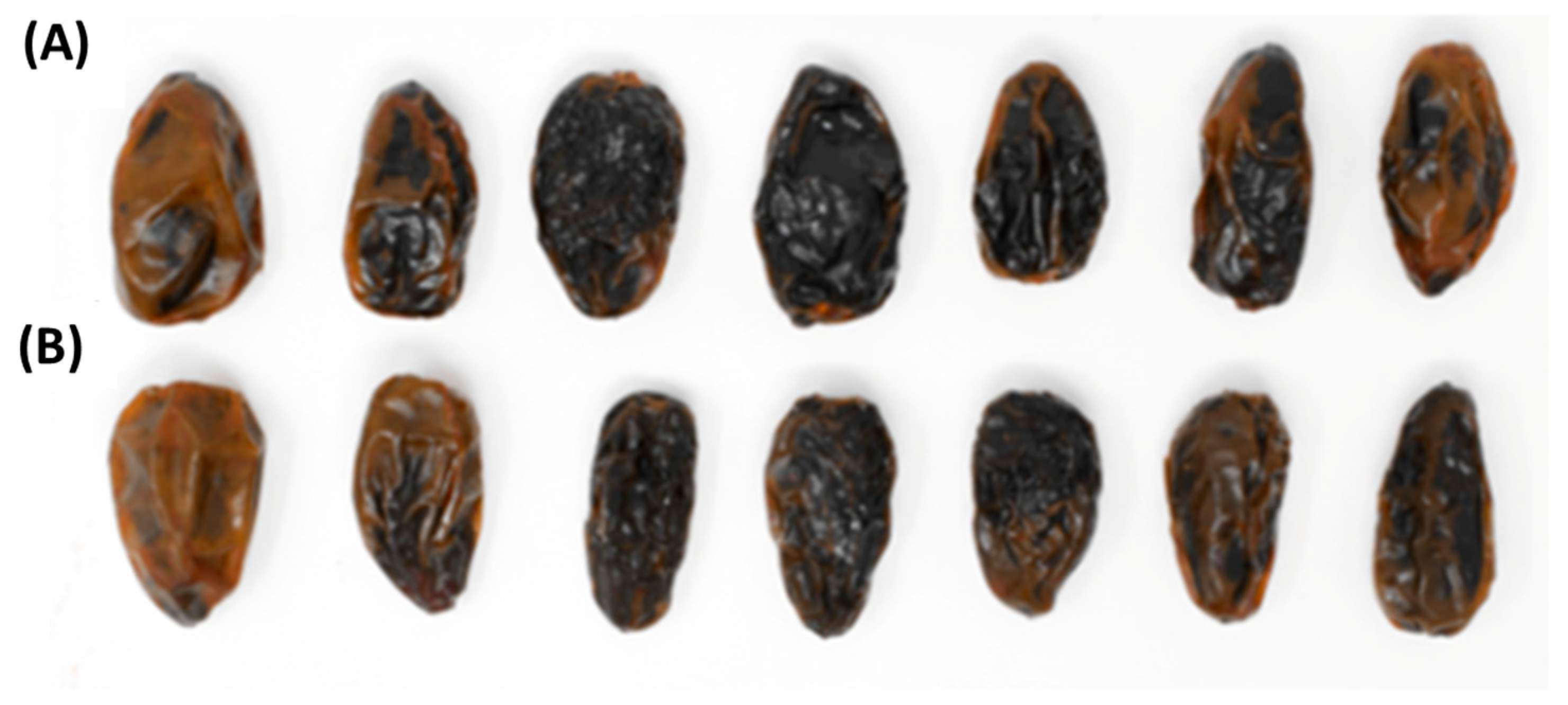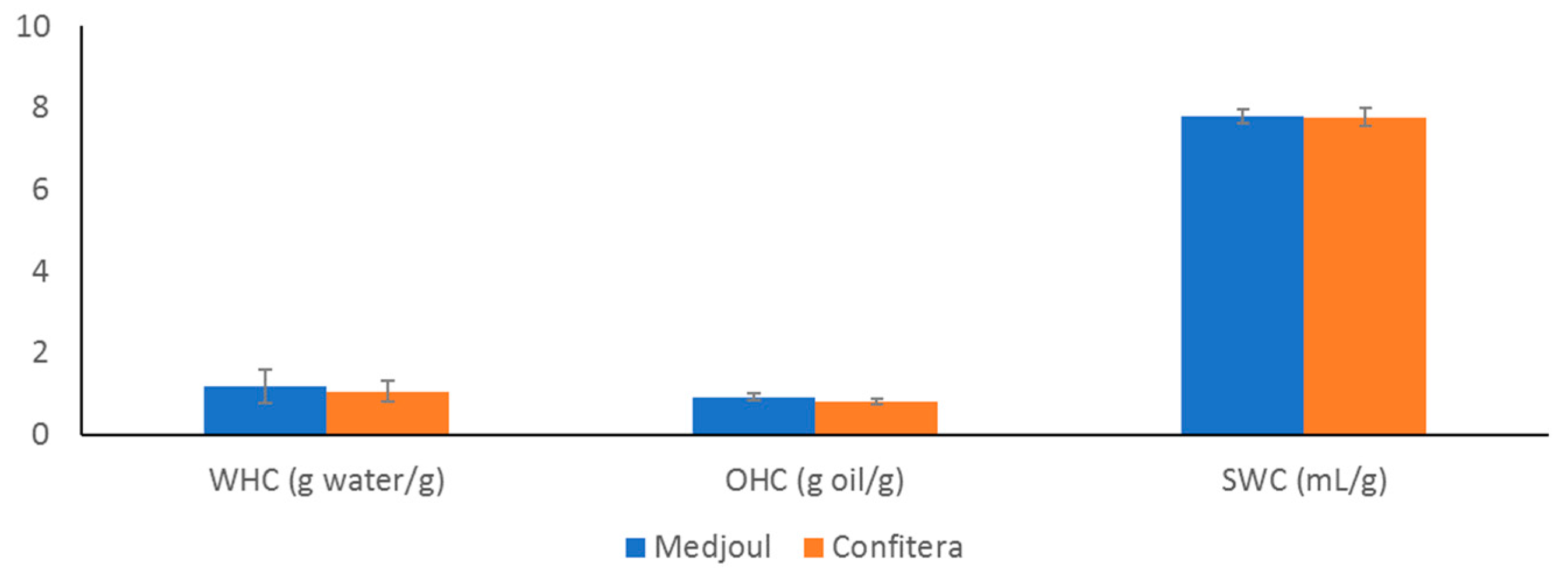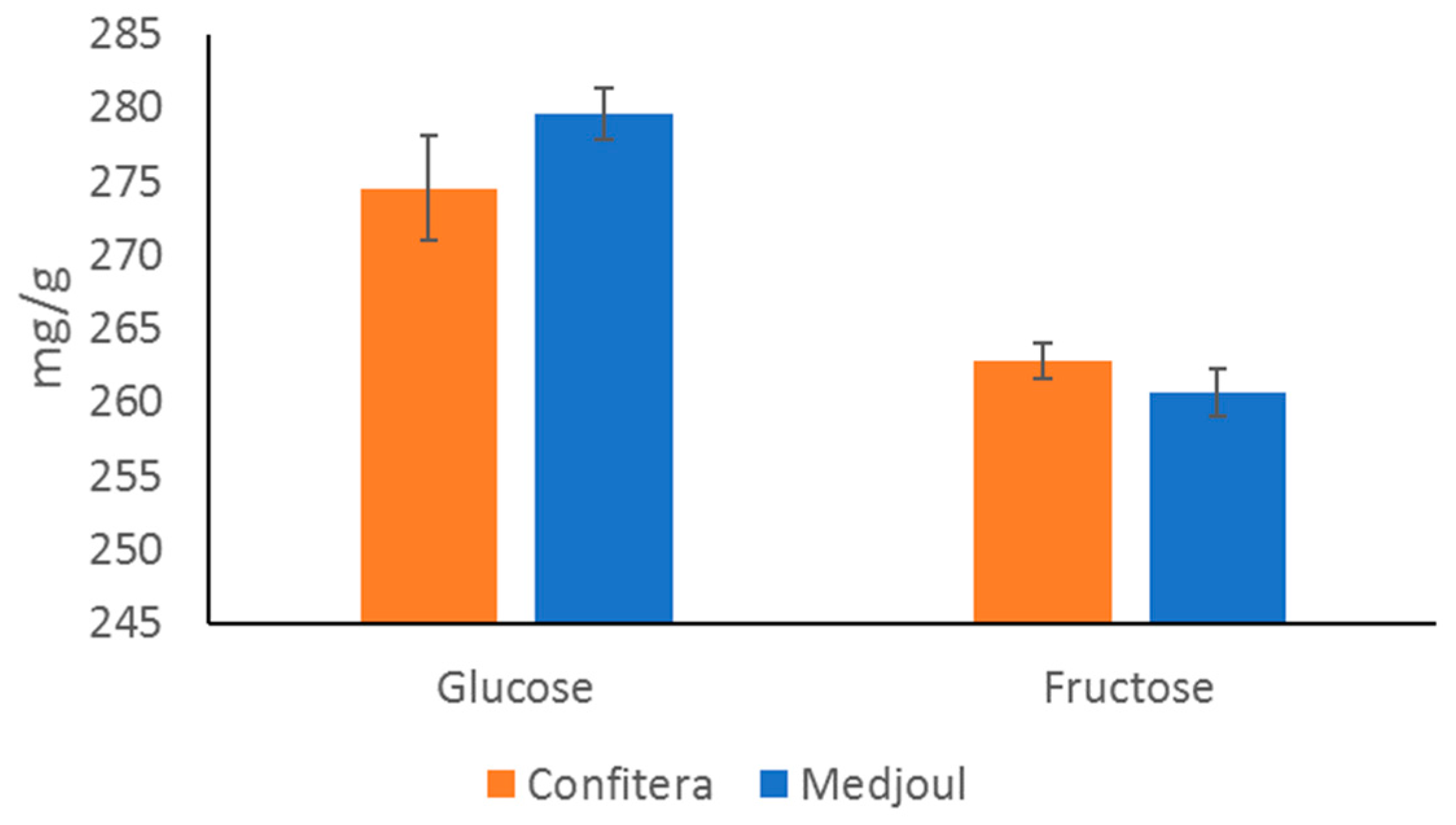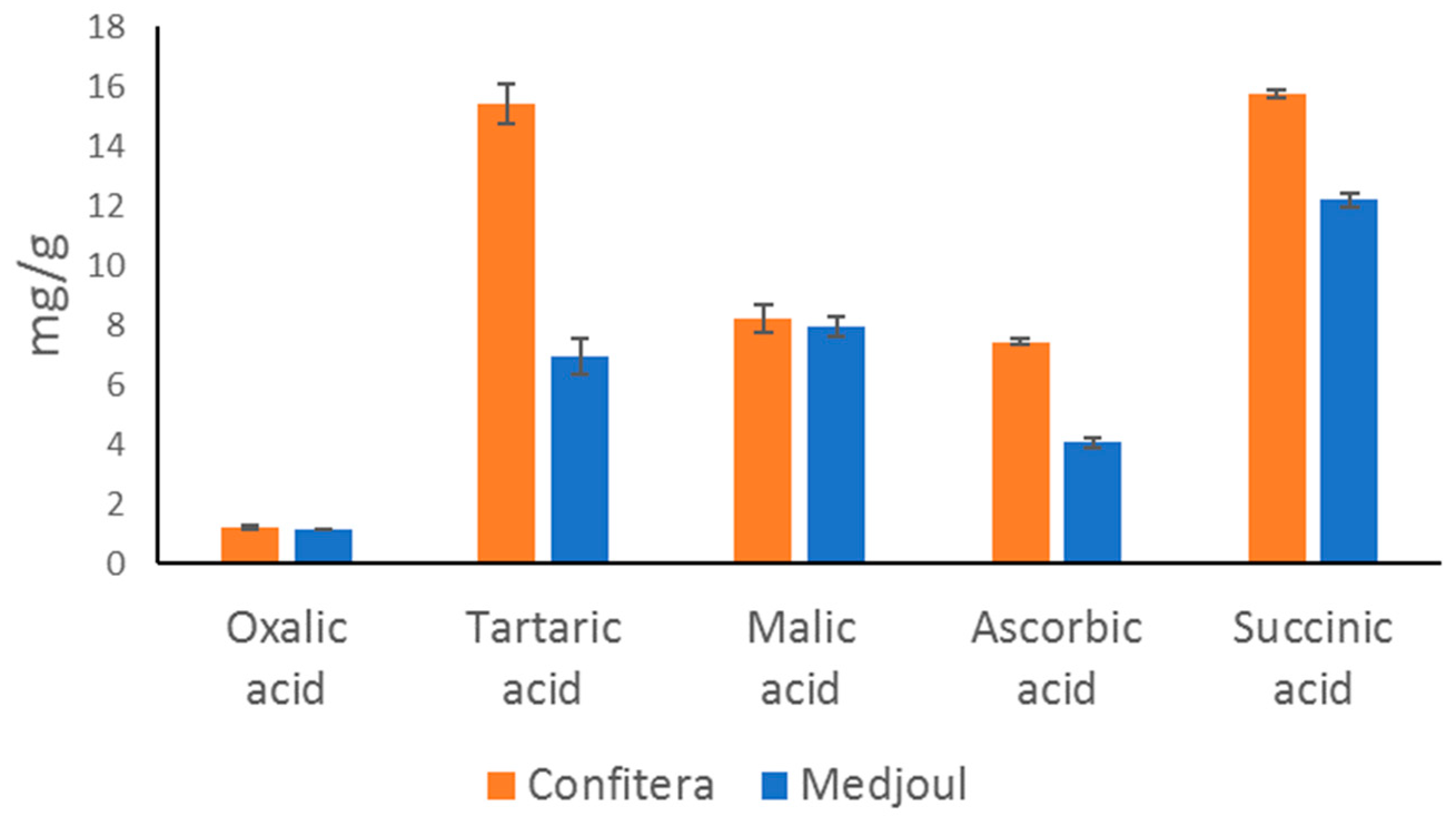Quality Characteristics of Fresh Date Palm Fruits of “Medjoul” and “Confitera” cv. from the Southeast of Spain (Elche Palm Grove)
Abstract
1. Introduction
2. Materials and Methods
2.1. Raw Materials
2.2. Morphological Characteristics
2.3. Physicochemical Properties
2.4. Technofunctional Properties
2.5. Proximate Composition
2.6. Organic Acids and Sugars Profile
2.6.1. Extraction of Organic Acid and Sugars
2.6.2. HPLC Analysis
2.7. Mineral Composition
2.8. Polyphenol Composition
2.9. Antioxidant Properties
2.10. Statistical Analysis
3. Results and Discussions
3.1. Morphological Characteristics
3.2. Physicochemical Properties
3.3. Techno-Fucntional Properties
3.4. Proximate Composition
3.5. Sugars and Organic Acids
3.6. Mineral Composition
3.7. Phenolic Composition and Antioxidant Activity
4. Conclusions
Author Contributions
Funding
Data Availability Statement
Acknowledgments
Conflicts of Interest
References
- Fernández-López, J.; Viuda-Martos, M.; Sayas-Barberá, E.; Navarro-Rodríguez de Vera, C.; Pérez-Álvarez, J.Á. Biological, nutritive, functional and healthy potential of date palm fruit (Phoenix dactylifera L.): Current research and future prospects. Agronomy 2022, 12, 876. [Google Scholar] [CrossRef]
- Echegaray, N.; Pateiro, M.; Gullón, B.; Amarowicz, R.; Misihairabgwi, J.; Lorenzo, J.M. Phoenix dactylifera products in human health—A review. Trends Food Sci. Technol. 2020, 105, 238–250. [Google Scholar] [CrossRef]
- Echegaray, N.; Gullón, B.; Pateiro, M.; Amarowicz, R.; Misihairabgwi, J.; Lorenzo, J.M. Date fruit and its by-products as promising source of bioactive components: A review. Food Rev. Int. 2021, 39, 1411–1432. [Google Scholar] [CrossRef]
- FAO. FAO Statistical Database (FAOSTAT); Food and Agriculture Organization of Unites National: Roma, Italy, 2022; Available online: https://www.fao.org/faostat/es/#data/QCL (accessed on 1 December 2022).
- Falade-Kolawole, O.; Abbo Emmanuel, S. Air-drying and rehydration characteristics of date palm (Phoenix dactylifera L.) fruits. J. Food Eng. 2007, 79, 724–730. [Google Scholar] [CrossRef]
- Özlem, E.; Yeliz, İ. Modeling of drying processes of dates (Phoenix, Arecaceae) with oven or TGA and microbiological properties of fresh and dried dates. Int. J. Fruit Sci. 2020, 20, S1530–S1538. [Google Scholar]
- Abu-Reidah, I.M.; Gil-Izquierdo, A.; Medina, S.; Ferreres, F. Phenolic composition profiling of different edible parts and by-products of date palm (Phoenix dactylifera L.) by using HPLC-DAD-ESI/MSn. Food Res. Int. 2017, 100, 494–500. [Google Scholar] [CrossRef] [PubMed]
- Salomón-Torres, R.; Ortiz-Uribe, N.; Valdez-Salas, B.; Rosas-González, N.; García-González, C.; Chávez, D.; Córdova-Guerrero, I.; Díaz-Rubio, L.; Haro-Vázquez, M.d.P.; Mijangos-Montiel, J.L.; et al. Nutritional assessment, phytochemical composition and antioxidant analysis of the pulp and seed of medjool date grown in Mexico. Peer J. 2019, 7, e6821. [Google Scholar] [CrossRef]
- El-Far, A.H.; Oyinloye, B.E.; Sepehrimanesh, M.; Allah, M.A.G.; Abu-Reidah, I.; Shaheen, H.M.; Razeghian-Jahromi, I.; Noreldin, A.E.; Al Jaouni, S.K.; Mousa, S.A. Date palm (Phoenix dactylifera): Novel findings and future directions for food and drug discover. Curr. Drug Discov. Technol. 2019, 16, 2–10. [Google Scholar] [CrossRef]
- El Arem, A.; Saafi, E.B.; Lahouar, L.; Bakhrouf, A.; Hammami, M.; Achour, L. Antibacterial activity and principal analysis of chemical composition and antioxidant activity of Tunisian date palm (Phoenix dactylifera L.) fruit during ripening. J. Bioresour. Valoriz. 2017, 2, 21–33. [Google Scholar]
- Taleb, H.; Maddocks, S.E.; Morris, R.K.; Kanekanian, A.D. Chemical characterization and the anti-inflammatory, anti-angiogenic and antibacterial properties of date fruit (Phoenix dactylifera L.). J. Ethnopharmacol. 2016, 194, 457–468. [Google Scholar] [CrossRef]
- Hussain, M.I.; Farooq, M.; Syed, Q.A. Nutritional and biological characteristics of the date palm fruit (Phoenix dactylifera L.)—A review. Food Biosci. 2020, 34, 100509. [Google Scholar] [CrossRef]
- Eid, N.M.S.; Al-Awadi, B.; Vauzour, D.; Oruna-Concha, M.J.; Spencer, J.P.E. Effect of cultivar type and ripening on the polyphenol content of date palm fruit. J. Agric. Food Chem. 2013, 61, 2453–2460. [Google Scholar] [CrossRef] [PubMed]
- Al-Qarni, S.S.M.; Bazzi, M.D. Date fruit ripening with degradation of chlorophylls, carotenes, and other pigments. Int. J. Fruit Sci. 2020, 20, S827–S839. [Google Scholar] [CrossRef]
- López-Marcos, M.C.; Bailina, C.; Viuda-Martos, M.; Pérez-Alvarez, J.A.; Fernández-López, J. Properties of dietary fibers from agroindustrial coproducts as source for fiber-enriched foods. Food Bioprocess Technol. 2015, 8, 2400–2408. [Google Scholar] [CrossRef]
- AOAC. Official Methods of Analysis of AOAC International, 21st ed.; AOAC International: Rockville, MD, USA, 2019. [Google Scholar]
- Melgarejo-Sánchez, P.; Martínez, J.J.; Legua, L.; Martínez, R.; Hernández, F.; Melgarejo, P. Quality, antioxidant activity and total phenols of six Spanish pomegranates clones. Sci. Hortic. 2015, 182, 65–72. [Google Scholar] [CrossRef]
- Genskowsky, E.; Puente, L.A.; Pérez-Álvarez, J.A.; Fernández-López, J.; Muñoz, L.A.; Viuda-Martos, M. Determination of polyphenolic profile, antioxidant activity and antibacterial properties of maqui [Aristotelia chilensis (Molina) Stuntz] a Chilean blackberry. J. Sci. Food Agric. 2016, 96, 4235–4242. [Google Scholar] [CrossRef]
- Brand-Williams, W.; Cuvelier, M.E.; Berset, C. Use of a free radical method to evaluate antioxidant activity. LWT Food Sci. Technol. 1995, 28, 25–30. [Google Scholar] [CrossRef]
- Gullón, B.; Pintado, M.E.; Fernández-López, J.; Pérez-Álvarez, J.A.; Viuda-Martos, M. In vitro gastrointestinal digestion of pomegranate peel (Punica granatum) flour obtained from co-products: Changes in the antioxidant potential and bioactive compounds stability. J. Funct. Foods 2015, 19, 617–628. [Google Scholar] [CrossRef]
- Oyaizu, M. Studies on products of browning reaction: Antioxidative activity of products of browning reaction prepared from glucosamine. Jpn. J. Nutr. 1986, 44, 307–315. [Google Scholar] [CrossRef]
- Mahdavi, B.; Yaacob, W.A.; Din, L.B. Chemical composition, antioxidant, and antibacterial activity of essential oils from Etlingera sayapensis A.D. Poulsen & Ibrahim. Asian Pac. J. Trop. Med. 2017, 10, 819–826. [Google Scholar] [CrossRef]
- Martín-Sánchez, A.M.; Vilella-Esplá, J.; Palou, L.l.; del Río, M.A.; Ben Abda, J.; Sayas-Barberá, E.; Pérez-Alvarez, J.A. Criterios técnicos de dátiles comercializados en España. Aliment. Equipos Tecnol. 2010, 29, 20–23. [Google Scholar]
- Muralidhara, B.M.; Singh, R.S.; Bhargava, R.; Veena, G.L.; Kumar, M.K. Morphological characterization of date fruits at different growth stages under hot arid conditions. Environ. Ecol. 2016, 34, 1234–1237. [Google Scholar]
- Al-Qurashi, A.D. Physico-chemical changes during development and ripening of Helali date palm fruit. J. Food Agric. Environ. 2010, 8, 404–408. [Google Scholar]
- Awad, M.A.; Al-Qurashi, A.D.; Mohamed, S.A. Biochemical changes in fruit of an early and a late palm cultivar during development and ripening. Int. J. Fruit Sci. 2011, 11, 167–183. [Google Scholar] [CrossRef]
- Meligi, M.A.; Sourial, G.F. Fruit Quality and General Evaluation of Some Iraqi Date Palm Cultivars Grown under Conditions of Barrage Region. In Proceedings of the First Symposium on the Date Palm Conference, AI-Hassa, Saudi Arabia, 23–25 March 1982; pp. 212–220. [Google Scholar]
- Al-Hoots, S.; Sidhu, J.S.; Qabazard, H. Physicochemical characteristics of five date fruit cultivars grown in the United Arab Emirates. Plant Foods Hum. Nutr. 1997, 50, 101–113. [Google Scholar] [CrossRef]
- Borchani, C.; Besbes, S.; Blecker, C.; Masmoudi, M.; Baati, R.; Attia, H. Chemical properties of 11 date cultivars and their corresponding fiber extract. Afr. J. Biotechnol. 2010, 9, 4096–4105. [Google Scholar]
- Almeida, J.; Assis, R.; Molineri, V.N.; Sestari, I.; Lira, B.S.; Carrari, F.; Peres, L.E.; Rossi, M. Fruits from ripening impaired, chlorophyll degraded and jasmonate insensitive tomato mutants have altered tocopherol content and composition. Phytochemistry 2015, 111, 72–83. [Google Scholar] [CrossRef]
- Ghnimi, S.; Umer, S.; Karim, A.; Kamal-Eldin, A. Date fruit (Phoenix dactylifera L.): An underutilized food seeking industrial valorization. NFS J. 2017, 6, 1–10. [Google Scholar] [CrossRef]
- Al-Okbi, S.Y. Date palm as source of nutraceuticals for health promotion: A review. Curr. Nutr. Rep. 2022, 11, 574–591. [Google Scholar] [CrossRef]
- Hazbavi, I.; Khoshtaghaza, M.H.; Mostaan, A.; Banakar, A. Effect of postharvest hot-water and heat treatment on quality of date palm (cv. Stamaran). J. Saudi Soc. Agric. Sci. 2015, 14, 153–159. [Google Scholar] [CrossRef]
- IRANOR. Nomenclatura Cromática Española; Instituto Nacional de Racionalización: Madrid, Spain, 1981. [Google Scholar]
- Dhingra, D.; Michael, M.; Rajput, H.; Patil, R.T. Dietary fibre in foods: A review. J. Food Sci. Technol. 2012, 49, 255–266. [Google Scholar] [CrossRef] [PubMed]
- Sahni, P.; Shere, D.M. Comparative evaluation of physico-chemical and functional properties of apple, carrot and beetroot pomace powders. Int. J. Food Ferment. Technol. 2017, 7, 317–323. [Google Scholar]
- Viuda-Martos, M.; López-Marcos, M.C.; Fernández-López, J.; Sendra, E.; López-Vargas, J.H.; Pérez-Alvarez, J.A. Role of fiber in cardiovascular diseases: A review. Compr. Rev. Food Sci. Food Saf. 2010, 9, 240–258. [Google Scholar] [CrossRef]
- Sharoba, A.M.; Farrag, M.A.; Abd El-Salam, A.M. Utilization of some fruits and vegetables waste as a source of dietary fiber and its effect on the cake making and its quality attributes. J. Agroalim. Process. Technol. 2013, 19, 429–444. [Google Scholar]
- Sánchez-Zapata, E.; Fernández-López, J.; Peñaranda, M.; Fuentes-Zaragoza, E.; Sendra, E.; Sayas, E.; Pérez-Alvarez, J.A. Technological properties of date paste obtained from date by-products and its effect on the quality of a cooked meat product. Food Res. 2011, 44, 2401–2407. [Google Scholar] [CrossRef]
- Chia, S.L.; Chong, G.H. Effect of drum drying on physico-chemical characteristics of dragon fruit peel (Hylocereus polyrhizus). Int. J. Food Eng. 2015, 11, 285–293. [Google Scholar] [CrossRef]
- Jasim, A.; Almusallam, A.; Al-Hooti, S.N. Isolation and characterization of insoluble date (Phoenix dactylifera L.) fibers. LWT Food Sci. Technol. 2012, 50, 414–419. [Google Scholar]
- Mrabet, A.; Hammadi, H.; Rodríguez-Gutierrez, G.; Jiménez-Araujo, A.; Sindic, M. Date palm fruits as a potential source of functional dietary fiber: A review. Food Sci. Technol. Res. 2019, 25, 1–10. [Google Scholar] [CrossRef]
- Majzoobi, M.; Karambakhsh, G.; Golmakani, M.T.; Mesbahi, G.R.; Farahnaky, A. Chemical composition and functional properties of date press cake, an agro-industrial waste. J. Agric. Sci. Technol. 2019, 21, 1807–1817. [Google Scholar]
- Sánchez-Zapata, E.; Fuentes-Zaragoza, E.; Fernández-López, J.; Sendra, E.; Sayas, E.; Navarro, C.; Pérez-Alvarez, J.A. Preparation of dietary fiber powder from tiger nut (Cyperus esculentus) milk (“Horchata”) byproducts and its physicochemical properties. J. Agric. Food Chem. 2009, 57, 7719–7725. [Google Scholar] [CrossRef]
- Al-Farsi, M.A.; Lee, C.Y. Nutritional and functional properties of dates: A review. Crit. Rev. Food Sci. Nutr. 2008, 48, 877–887. [Google Scholar] [CrossRef] [PubMed]
- El Arem, A.; Saafi, E.B.; Flamini, G.; Issaoui, M.; Ferchichi, A.; Hammami, M.; Helall, A.N.; Achour, L. Volatile and nonvolatile chemical composition of some date fruits (Phoenix dactylifera L.) harvested at different stages of maturity. Int. J. Food Sci. Technol. 2012, 47, 549–555. [Google Scholar] [CrossRef]
- Vinita, D.P. Nutritional composition of fruit of four date palm (Phoenix dactylifera L.) cultivars grown in Haryana, India. Asian J. Dairy Food Res. 2016, 35, 331–334. [Google Scholar] [CrossRef]
- Martín-Sánchez, A.M.; Cherif, S.; Vilella-Esplá, J.; Ben-Abda, J.; Kuri, V.; Pérez-Álvarez, J.Á.; Sayas-Barberá, E. Characterization of novel intermediate food products from Spanish date palm (Phoenix dactylifera L., cv. Confitera) co-products for industrial use. Food Chem. 2014, 154, 269–275. [Google Scholar] [CrossRef]
- Tassoult, M.; Kati, D.E.; Fernández-Prior, M.Á.; Bermúdez-Oria, A.; Fernandez-Bolanos, J.; Rodríguez-Gutiérrez, G. Antioxidant capacity and phenolic and sugar profiles of date fruits extracts from six different Algerian cultivars as influenced by ripening stages and extraction systems. Foods 2021, 10, 503. [Google Scholar] [CrossRef] [PubMed]
- Ashraf, Z.; Hamidi-Esfahani, Z. Date and date processing: A review. Food Rev. Int. 2011, 27, 101–133. [Google Scholar] [CrossRef]
- Rastegar, S.; Rahemir, M.; Bagihzadeg, A.; Gholami, M. Enzyme activity and biochemical changes of three date palm cultivars with different softening pattern during ripening. Food Chem. 2012, 134, 1279–1286. [Google Scholar] [CrossRef]
- Bouhlali, E.d.T.; Ramchoun, M.; Alem, C.; Ghafoor, K.; Ennassir, J.; Zegzouti, Y.F. Functional composition and antioxidant activities of eight Moroccan date fruit varieties (Phoenix dactylifera L.). J. Saudi Soc. Agric. Sci. 2017, 16, 257–264. [Google Scholar] [CrossRef]
- EFSA (European, Food Safety Authority). Dietary reference values for sodium. EFSA J. 2019, 17, 5778. [Google Scholar] [CrossRef]
- El Hadrami, A.; Daayf, F.; Elshibli, S.; Jain, S.M.; El Hadrami, I. Somaclonal Variation in Date Palm. In Date Palm Biotechnology; Jain, S., Al-Khayri, M.J.M., Johnson, D.V., Eds.; Springer: Dordrechrt, The Netherlands, 2011; pp. 183–203. [Google Scholar]
- Nematallah, K.H.; Ayoub, N.A.; Abdelsattar, E.; Meselhy, M.R.; Elmazar, M.M.; El-Khatib, A.H.; Linscheid, M.W.; Hathout, R.M.; Godugu, K.; Adel, A.; et al. Polyphenols LC-MS2 profile of Ajwa date fruit (Phoenix dactylifera L.) and their microemulsion: Potential impact on hepatic fibrosis. J. Funct. Foods 2018, 49, 401–411. [Google Scholar] [CrossRef]
- Hong, Y.J.; Tomas-Barberan, F.A.; Kader, A.A.; Mitchell, A.E. The flavonoid glycosides and procyanidin composition of Deglet Noor dates (Phoenix dactylifera). J. Agric. Food Chem. 2006, 54, 2405–2411. [Google Scholar] [CrossRef] [PubMed]
- Mrabet, A.; Jiménez-Araujo, A.; Fernández-Bolaños, J.; Rubio-Senent, F.; Lama-Muñoz, A.; Sindic, M.; Rodríguez-Gutiérrez, G. Antioxidant phenolic extracts obtained from secondary Tunisian date varieties (Phoenix dactylifera L.) by hydrothermal treatments. Food Chem. 2016, 196, 917–924. [Google Scholar] [CrossRef] [PubMed]
- Hachani, S.; Hamia, C.; Boukhalkhal, S.; Silva, A.M.; Djeridane, A.; Yousfi, M. Morphological, physico-chemical characteristics and effects of extraction solvents on UHPLC-DAD-ESI-MSn profiling of phenolic contents and antioxidant activities of five date cultivars (Phoenix dactylifera L.) growing in Algeria. NFS J. 2018, 13, 10–22. [Google Scholar] [CrossRef]
- Mansouri, A.; Embarek, G.; Kokkalou, E.; Kefalas, P. Phenolic profile and antioxidant activity of the Algerian ripe date palm fruit (Phoenix dactylifera). Food Chem. 2005, 89, 411–420. [Google Scholar] [CrossRef]
- Hamad, I.; AbdElgawad, H.; Al Jaouni, S.; Zinta, G.; Asard, H.; Hassan, S.; Selim, S. Metabolic analysis of various date palm fruit (Phoenix dactylifera L.) cultivars from Saudi Arabia to assess their nutritional quality. Molecules 2015, 20, 13620–13641. [Google Scholar] [CrossRef]
- Abdul-Hamid, N.A.; Mustaffer, N.H.; Maulidiani, M.; Mediani, A.; Ismail, I.S.; Tham, C.L.; Shadid, K.; Abas, F. Quality evaluation of the physical properties, phytochemicals, biological activities and proximate analysis of nine Saudi date palm fruit varieties. J. Saudi Soc. Agric. Sci. 2020, 19, 151–160. [Google Scholar] [CrossRef]
- Allaith, A.A.A. Antioxidant activity of Bahraini date palm (Phoenix dactylifera L.) fruit of various cultivars. Int. J. Food Sci. Technol. 2008, 43, 1033–1040. [Google Scholar] [CrossRef]
- Al-Mssallem, M.Q.; Alqurashi, R.M.; Al-Khayri, J.M. Bioactive Compounds of Date Palm (Phoenix dactylifera L.). In Bioactive Compounds in Underutilized Fruits and Nuts; Murthy, H., Bapat, V., Eds.; Springer: Luxemburg, 2020; pp. 91–103. [Google Scholar]




| Date cv. | Length (cm) | Width (cm) | Total Weight (g) | Pulp Weight (g) | Skin Weight (g) | Seed Weight (g) |
|---|---|---|---|---|---|---|
| Medjoul | 3.88 ± 0.36 | 2.14 ± 0.25 | 11.64 ± 3.85 | 9.08 ± 3.16 | 1.15 ± 0.37 | 1.23 ± 0.45 |
| Confitera | 4.58 ± 0.22 | 2.14 ± 0.17 | 13.12 ± 1.61 | 10.97 ± 1.48 | 1.09 ± 0.20 | 0.97 ± 0.17 |
| p value | 0.000 | 0.943 | 0.122 | 0.021 | 0.485 | 0.018 |
| Date cv. | pH | L* | a* | b* | C* | H* |
|---|---|---|---|---|---|---|
| Medjoul | 5.74 ± 0.02 | 32.50 ± 1.11 | 4.39 ± 0.65 | 4.96 ± 1.04 | 6.63 ± 1.20 | 48.22 ± 2.04 |
| Confitera | 5.94 ± 0.04 | 32.36 ± 0.30 | 5.13 ± 0.35 | 5.85 ± 0.33 | 7.78 ± 0.36 | 48.72 ± 2.32 |
| p value | 0.003 | 0.732 | 0.009 | 0.028 | 0.014 | 0.640 |
| Date cv. | Moisture | Protein | Fat | TDF 1 | Ash | Sugars |
|---|---|---|---|---|---|---|
| Medjoul | 32.38 ± 0.52 | 1.98 ± 0.05 | 0.37 ± 0.05 | 20.05 ± 0.81 | 2.05 ± 0.07 | 43.17 ± 0.67 |
| Confitera | 25.65 ± 0.65 | 2.58 ± 0.18 | 0.18 ± 0.04 | 21.94 ± 0.94 | 2.06 ± 0.03 | 47.59 ± 0.76 |
| p value | 0.000 | 0.032 | 0.009 | 0.291 | 0.820 | 0.043 |
| Component | Medjoul | Confitera | p Value |
|---|---|---|---|
| K | 639.39 ± 47.67 | 837.33 ± 68.82 | 0.013 |
| Mg | 89.82 ± 5.37 | 114.65 ± 7.41 | 0.009 |
| Ca | 100.62 ± 5.50 | 98.65 ± 1.72 | 0.325 |
| Na | 30.68 ± 0.61 | 43.15 ± 0.85 | 0.031 |
| Fe | 1.20 ± 0.01 | 1.70 ± 0.30 | 0.024 |
| Zn | 0.83 ± 0.08 | 0.99 ± 0.09 | 0.019 |
| Cu | 0.65 ± 0.07 | 0.62 ± 0.03 | 0.287 |
| Mn | 0.39 ± 0.02 | 0.50 ± 0.01 | 0.037 |
| Compound | Medjoul | Confitera | p Value |
|---|---|---|---|
| (−) Epicatechin | LOD | 1241.90 ± 1.13 | - |
| Luteolin-7-O-glucoside | 26.61 ± 0.74 | 8.21 ± 0.47 | 0.012 |
| (+) Catechin | LOD | 1150.89 ± 1.86 | - |
| Caffeic acid | 3.37 ± 0.09 | 3.32 ± 0.06 | 0.231 |
| Eriocitrin | 8.76 ± 0.23 | 10.85 ± 0.12 | 0.027 |
| Hesperidin | 7.47 ± 0.32 | 16.76 ± 0.41 | 0.013 |
| Rutin | 11.00 ± 0.48 | 12.97 ± 0.63 | 0.042 |
| Isoquercitrin | 19.03 ± 0.74 | 10.43 ± 0.36 | 0.031 |
| Date cv. | FRAP (mg TE/g Pulp) | DPPH (μg TE/g Pulp) | FIC (μg EDTA/g Pulp) | ABTS (mg TE/g Pulp) |
|---|---|---|---|---|
| Medjoul | 0.64 ± 0.05 | 26.46 ± 2.11 | 3.75 ± 0.39 | 1.14 ± 0.28 |
| Confitera | 0.78 ± 0.06 | 32.33 ± 3.13 | 4.63 ± 0.87 | 0.91 ± 0.14 |
| p value | 0.001 | 0.003 | 0.046 | 0.097 |
Disclaimer/Publisher’s Note: The statements, opinions and data contained in all publications are solely those of the individual author(s) and contributor(s) and not of MDPI and/or the editor(s). MDPI and/or the editor(s) disclaim responsibility for any injury to people or property resulting from any ideas, methods, instructions or products referred to in the content. |
© 2023 by the authors. Licensee MDPI, Basel, Switzerland. This article is an open access article distributed under the terms and conditions of the Creative Commons Attribution (CC BY) license (https://creativecommons.org/licenses/by/4.0/).
Share and Cite
Muñoz-Bas, C.; Muñoz-Tebar, N.; Candela-Salvador, L.; Pérez-Alvarez, J.A.; Lorenzo, J.M.; Viuda-Martos, M.; Fernández-López, J. Quality Characteristics of Fresh Date Palm Fruits of “Medjoul” and “Confitera” cv. from the Southeast of Spain (Elche Palm Grove). Foods 2023, 12, 2659. https://doi.org/10.3390/foods12142659
Muñoz-Bas C, Muñoz-Tebar N, Candela-Salvador L, Pérez-Alvarez JA, Lorenzo JM, Viuda-Martos M, Fernández-López J. Quality Characteristics of Fresh Date Palm Fruits of “Medjoul” and “Confitera” cv. from the Southeast of Spain (Elche Palm Grove). Foods. 2023; 12(14):2659. https://doi.org/10.3390/foods12142659
Chicago/Turabian StyleMuñoz-Bas, Clara, Nuria Muñoz-Tebar, Laura Candela-Salvador, José A. Pérez-Alvarez, José M. Lorenzo, Manuel Viuda-Martos, and Juana Fernández-López. 2023. "Quality Characteristics of Fresh Date Palm Fruits of “Medjoul” and “Confitera” cv. from the Southeast of Spain (Elche Palm Grove)" Foods 12, no. 14: 2659. https://doi.org/10.3390/foods12142659
APA StyleMuñoz-Bas, C., Muñoz-Tebar, N., Candela-Salvador, L., Pérez-Alvarez, J. A., Lorenzo, J. M., Viuda-Martos, M., & Fernández-López, J. (2023). Quality Characteristics of Fresh Date Palm Fruits of “Medjoul” and “Confitera” cv. from the Southeast of Spain (Elche Palm Grove). Foods, 12(14), 2659. https://doi.org/10.3390/foods12142659









